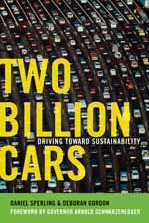SEJournal Online is the digital news magazine of the Society of Environmental Journalists. Learn more about SEJournal Online, including submission, subscription and advertising information.

BookShelf
Two Billion Cars: Driving Toward Sustainability
By Daniel Sperling and Deborah Gordon
Oxford University Press, $24.95
Reviewed by JENNIFER WEEKS
The environmental impacts of America's love affair with automobiles, as Daniel Sperling and Deborah Gordon lay them out in Two Billion Cars, are so depressing that readers may want to start this book at the end. There the authors sketch out a vision for a sustainable transportation system, circa 2050, that doesn't depend on oil or vehicles powered by internal combustion engines.
In this world people carry pocket-sized computers that offer transportation options at the click of a few buttons, including car-sharing, ride-sharing, bus rapid transit and other choices. Private autos are powered with hydrogen (made from clean fuels) or a combination of electricity and cellulosic biofuels. Carbon emissions from transportation are 50 to 80 percent lower than today's levels, the air is cleaner, and roads are less crowded.
With that picture in mind, it's a little easier to flip to the front of the book and see how we get there from here. Sperling, a professor of engineering and environmental policy at the University of California-Davis, and Gordon, a transportation policy analyst, start with a clear message: the United States has created a transportation monoculture that resists innovation, and the rest of the world is following suit. That path leads to a planet with two billion cars and other vehicles by 2020, which is unsustainable for many reasons, including climate change, regional air pollution, and competition for scarce oil resources. Even today's most innovative alternatives, such as the Toyota Prius and Brazil's sugar-based ethanol industry, are baby steps toward the changes that are needed. "The world is still in denial about the staggering challenge it faces and the radical transformation it must undertake," the authors warn.
How can we break the transportation monoculture? Sperling and Gordon say it will take a major shift to electric-drive technology, which is much more efficient than internal combustion engines (today's gasoline engines waste about two-thirds of the fuel they burn). Hybrid electric vehicles like those on the roads today are a start, but battery electric cars and fuel cells will eventually become the dominant options. The best use of biofuels, the authors believe, is as substitutes for electric vehicles in areas like the U.S. Midwest where most electricity comes from coal (so heavy use of electric vehicles would increase greenhouse gas and criteria pollutant emissions from coal-burning power plants).
Along with new fuels, we also need new kinds of transportation that give people alternatives to driving alone. Sperling and Gordon don't see conventional mass transit as a solution, at least in wealthy nations, because it doesn't attract enough users. Instead they look to new services that use information and wireless technologies to offer options like "smart paratransit" (on-demand local shuttle service without fixed routes or schedules), small neighborhood vehicles, and telecommuting. Giving people more ways to get from A to B, they argue, will make them more willing to get out of their cars.
This book also looks critically at the U.S. auto industry and large oil companies and the business cultures that make them resist innovation. Sperling and Gordon are skeptical of arguments that world oil production is nearing its peak, but they see a different problem. Oil companies may be able to tap unconventional sources like Canadian tar sands and western oil shale, but these sources are dirtier and more expensive than conventional oil reserves. "The world is caught in a trap and oil is the bait," they write. Without new policies that make energy companies invest much more heavily in alternative fuels, Big Oil will keep doing what it does best: large fossil energy projects.
Car makers and consumers also need to change their ways. Automakers are starting to shift toward electric-drive vehicles, but higher fuel economy requirements and greenhouse gas emissions standards would push them along. Price floors for gasoline and diesel would give investors more incentive to support alternative fuels. And incentives like pay-as-you-drive insurance would make consumers think more about how many miles they log in their cars.
Transportation coverage has focused this year on restructuring of the Big Three automakers, but solutions are more likely to come from places that have the most to gain from finding alternatives. This book spotlights two: California, which is pioneering greenhouse gas emission standards for cars, and China, which the authors believe could become a leader in transforming vehicles, fuels and mobility options — especially if wealthy countries help China develop sustainable transportation strategies. The road to a 21st century transportation system may take some strange turns, but this book is a good travel guide.
Freelance writer Jennifer Weeks is based in Watertown, Mass. She and Deborah Gordon both worked at the Union of Concerned Scientists from 1994-96.
** From the quarterly newletter SEJournal Fall 2009 issue.












 Advertisement
Advertisement 



